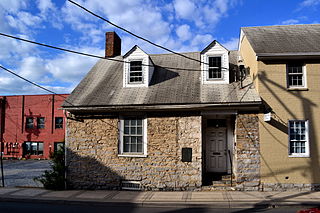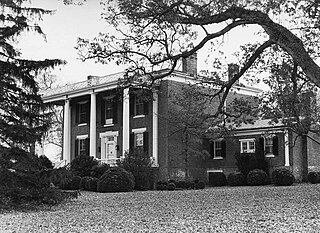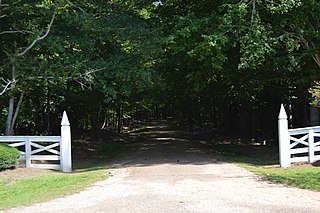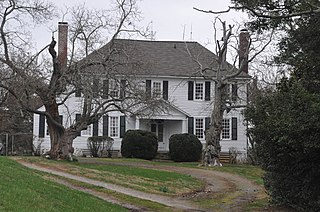
Thomas Harrison House is a historic home located at Harrisonburg, Virginia. It was built between 1790 and 1800 and is a 1½-story, two bay by one bay, coursed limestone vernacular dwelling. It has a gable roof and was built over a spring, which is accessible in the basement. It is the oldest house in Harrisonburg and its namesake is regarded as the town's founder.

The Mary Baldwin University, Main Building is a historic building on the Mary Baldwin University campus in Staunton, Virginia. It was built in 1844, and is a Greek Revival style educational building. It consists of a two-story, five bay central section, flanked by three-bay two-story wings with full basement and projecting gable ends. The front facade features a four-bay portico with four Greek Doric order columns supporting a Doric entablature and pediment.

Clifton is a historic plantation house located near Hamilton, Cumberland County, Virginia. It was built about 1760, and is a two-story, seven-bay frame dwelling in the Georgian style. It has a hipped roof and a one-bay, one-story wing on the west end. The front facade features a three-bay, one-story gable roof porch supported by elongated Tuscan order columns. It was the home of Carter Henry Harrison, who as a member of the Cumberland Committee of Safety, wrote the Instructions for Independence presented to the Virginia Convention of May 1776.

Santillane is a historic home located near Fincastle, Botetourt County, Virginia. It was built in 1795, and consists of a two-story high, three bay by four bay, main block with a one-story, rear kitchen wing. It is constructed of brick and is in the Greek Revival style. The house has a shallow hipped roof and tetrastyle two-story front portico dated to the early 20th century. Also on the property is a contributing stone spring house. The house stands on a tract purchased by Colonel George Hancock (1754–1820) in 1795. The kitchen wing may date to his period of ownership.

Margots, also known as Eagle's Nest, Eagles Lodge, and Claybancke, is a historic home located near Tettington, Charles City County, Virginia. It was originally built about 1700, as a 1+1⁄2-story, three-bay brick structure above a basement, until raised by addition of a frame second story in the 19th century. The house measures 44 feet, 4 inches, by 20 feet, 8 inches. It is one of a few surviving circa 1700 medium-sized houses of Tidewater Virginia. In 1973, the property was sold to the Virginia Commission of Game and Inland Fisheries by the Beale Estate.

A. P. Hill Boyhood Home is a historic home located at Culpeper, Culpeper County, Virginia, United States.

Holly Hill is a historic plantation house near Aylett in King and Queen County, Virginia. It was built about 1820 and is a two-story, five-bay-by-two-bay Georgian-style brick dwelling. It has a hipped roof and four-bay rear ell.

Hesse is a historic plantation house located near Blakes, Mathews County, Virginia. It was built about 1725, and is a five-bay, two-story Georgian style brick dwelling. It has a single-pile plan and is topped by a gable roof. A modern five-bay flanking south wing was built in 1952.

Shadow Lawn is a historic home located at Chase City, Mecklenburg County, Virginia. The original section dates to about 1834, with the main Italianate style front section designed by Jacob W. Holt and built in 1869–1870. The house is two stories tall and three bays wide with a cross gable roof. It has a traditional central-passage, double-pile plan.

MacCallum More and Hudgins House Historic District is a pair of historic homes and national historic district located at Chase City, Mecklenburg County, Virginia. The district encompasses three contributing buildings and one contributing site They include the Hudqins-Rutledqe House built in 1910. The house is a two-story, frame dwelling with a symmetrical two-bay façade that combines Colonial Revival and Neoclassical elements. MacCallum More was designed by noted Richmond architect Carl M. Lindner and built in 1929. It is Colonial Revival in style with a three-bay, symmetrical façade and a side gable roof. It has a two-story central block flanked by one-story wings. Associated with it is a 1+1⁄2-story, Guest Cottage built about 1941. The houses are located in landscaped gardens designed by Charles Gillette in 1927.

Page County Courthouse is a historic courthouse building located at Luray, Page County, Virginia. It was built in 1832–1833, and consists of a two-story, four-bay court house with three-bay, one-story wings. The four-bays of the pedimented gable facade open onto a ground floor arcade with rounded arches in the Jeffersonian Roman Revival style. It is topped by a cupola with coupled pilasters and four pedimented gables. It was built by Malcolm Crawford and William B. Philips, who worked under Thomas Jefferson on the University of Virginia.

Montpelier is a historic plantation house located near Sperryville, Rappahannock County, Virginia. The main house was built about 1750, and is a two-story, 11 bay, stuccoed stone and brick dwelling with a side gable roof. It consists of a five-bay main block with north and south three bay wings. It features a two-story verandah stretching the entire length of the house with eight large provincial Tuscan order columns. The property also includes the contributing smokehouse, storage house, and a frame cabin. It was added to the National Register of Historic Places in 1973.

Baxter House is a historic home located near Edom, Rockingham County, Virginia. The house dates to about 1775, and is a single pile, double-pen dwelling consisting of two abutted two-bay, two-story log structures set on limestone foundation. It was built by Scottish settler George Baxter, whose son George A. Baxter served as president of Washington and Lee University from 1799 to 1829.

John K. Beery Farm is a historic home and farm complex located near Edom, Virginia, United States. The main house dates to 1838, and consists of a two-story, five-bay, central-hall plan, main section with a one-story, three-bay east wing. The main section measures 50 feet wide and 18 feet deep and features a long one-story, late-19th century porch. Also on the property are a number of contributing outbuildings including a stone bank barn, loom house, spring house, wash house / kitchen, granary, sheds, and an outhouse. The meeting room in the east wing of the house served a large congregation of Mennonites for a number of years. John K. Berry was a descendant of Swiss settlers in Pennsylvania.

Old Russell County Courthouse, also known as the Dickenson-Fugate House, is a historic courthouse building located near Dickensonville, Russell County, Virginia. It consists of a simple stone court house built about 1799, attached to the side of a more sophisticated brick farmhouse, which probably dates from the second quarter of the 19th century. Both sections are two stories and three bays wide and the brick section has a rear ell. It served as the second location for the Russell County courthouse, until the county seat moved to Lebanon in 1818.

Carlton is a historic home located at Falmouth, Stafford County, Virginia. It was built about 1785, and is a two-story, five-bay, Georgian style frame dwelling. It has a hipped roof, interior end chimneys, and a front porch added about 1900. The house measures approximately 48 feet by 26 feet. Also on the property are the contributing frame kitchen partially converted to a garage, frame dairy, and brick meat house.

Sussex County Courthouse Historic District is a historic courthouse complex and national historic district located at Sussex, Sussex County, Virginia. The district encompasses four buildings in the complex: the clerk's office (1924), the court house, the County Office Building, jail and the Dillard House. Other buildings are the mid-19th century county treasurer's office and the John Bannister House. The county courthouse building was built in 1828 by Dabney Cosby, and is a two-story, seven-bay, Jeffersonian Classicism style brick building. It has a cross-gable roof with cupola and features a three-bay arcade, one-bay deep with five rounded arches, on its front facade. A six-bay brick addition was built in 1954. The building is one of a number of county courthouses inspired by the architecture of Thomas Jefferson, who employed its builder Dabney Cosby in the building of the University of Virginia.

June Tolliver House, also known as the June Tolliver House & Folk Art Center, is a historic home located at Big Stone Gap, Wise County, Virginia. It was built in 1890, and is a 2+1⁄2-story, three-bay Queen Anne-style brick dwelling. It has complex gable roof with projecting end bays. It is recognized as the house in which June Morris, the prototype of June Tolliver, heroine of John Fox, Jr.'s The Trail of the Lonesome Pine boarded when she came to school in Big Stone Gap. The house is open as a museum.

Chesterville Plantation Site is a historic archaeological site located on the grounds of NASA Langley Research Center in Hampton, Virginia. The main house was built about 1771, and was a two-story brick house set on a high basement, with a three-bay gable end front, and stuccoed brick walls. The site includes the remains of the house, the ruins of a building with a ballast stone foundation, the foundation of a brick kiln, a cemetery, and scattered evidence of 17th century occupation. In 1755 George Wythe (1726-1806) inherited the property believed to have been his birthplace, and built the Chesterville Plantation house about 1771. It was his primary place of residence until 1775 and he continued to operate a plantation there until 1792. The mansion was destroyed by fire in 1911.

The Taylor–Mayo House, also known as the Mayo Memorial Church House, is a historic home located in Richmond, Virginia. It was built in 1845, and is a two-story, five-bay, Greek Revival style dwelling topped by a hipped roof. The front facade features a three-bay two-story Ionic order portico. The house was elaborately renovated during the 1880s.
























